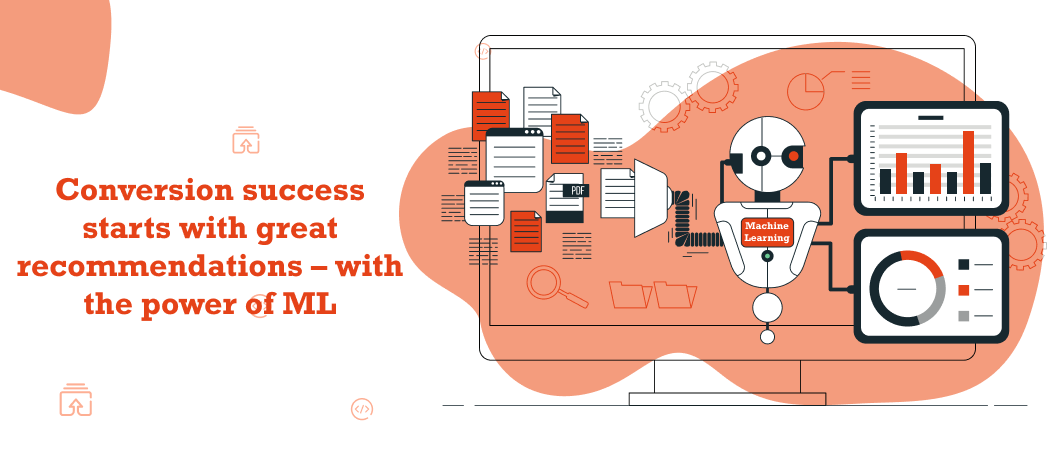Ever since ChatGPT came into being, the entire world has become obsessed with Artificial Intelligence (AI) and Machine Learning (ML) and all the (seemingly impossible) things they can do. While the buzz is recent, organizations have long used these technologies to improve how they respond to situations by training models on data, the focus has now shifted to recommendation systems.
It is estimated that the recommendation engine market will be worth $43.8 billion by 2031, growing at a CAGR of 32.1%.
But how can you successfully build a recommendation engine?
Why Are Recommendation Engines in Trend?
The continued adoption of digital technologies and rising competition have made it difficult for companies to stand out in the market. With customer expectations growing, organizations must drive higher levels of personalization and customization. Recommendation engines streamline the purchasing journey for customers by recommending or suggesting products that best fit their needs.
Using a combination of complex machine learning algorithms and deep learning techniques, recommendation engines enable organizations to:
Understanding User Preferences
Understand user preferences by contextually analyzing their past behavior, purchases, and history.
Real-Time Personalized Recommendations
Provide customers with personalized and relevant product and service recommendations in real-time.
Enabling Product Discovery
Enable product discovery via collaborative or content-based filtering on the products customers search for.
Reporting and Analysis
Access reports on most-liked (or most disliked) or most-viewed (or never-viewed) products and take steps to improve product satisfaction/reach.
Revenue Enhancement
Boost revenue by delivering recommendations to customers that best fit their current needs.
What Does It Take to Build a Powerful Recommendation Engine?
As AI becomes ubiquitous, there is a pressing demand for recommendation engines to be extremely sophisticated. They need to accurately collect, store, analyze, and filter large data sets and deliver recommendations in real-time. These recommendations must be based on essential purchases as well as seasonal needs to increase brand loyalty and customer retention. Here’s what it takes to build a powerful recommendation engine:
1. Requirements Understanding
Simple yet critical, the first step in building a recommendation engine is understanding the requirements and defining the goals of the project. This involves having discussions between business and IT teams, including leadership executives, product managers, and user experience teams.
You must also clarify the functional, non-functional, and system requirements of your engine. In addition, you must be clear on the development architecture, testing requirements, and agile methodologies you will use to build a state-of-the-art recommendation engine.
2. Accurate and Consistent Data Sets
The best recommendation systems are those that base their recommendations on millions of terabytes of data. To ensure comprehensive and accurate recommendations, it is important to feed your system accurate and consistent data sets. Gather and input both explicit and implicit user feedback.
Also, remember to take evolving user preferences into account. Consider paying more attention to datasets that are more likely to represent the user’s current tastes and remove older data that might no longer be relevant.
3. Smart Data Access and Storage
The recommendation engine you build will need to rely on massive volumes of data to deliver the right outcomes. Being able to access the right data at the required speed to deliver recommendations that can influence buying decisions will become key. Investing in a cloud-based data warehouse is critical to the success of your engine. While there is no single option that would meet the needs of your recommendation engine, the idea is to embrace a solution that can deal with humongous data volumes and a variety of data types to accelerate the speed of decision-making.
4. Instant Data Capture
Recommendation engines need to provide recommendations in real-time. That suggests the need for continuous data capture to feed the ML engine. One way to empower instant decisions is by exploiting the capabilities of cutting-edge technologies like edge computing. By processing data from customer activity instantaneously, data analytics and ML systems can offer advice and suggestions that exactly match their behavior and current state of mind.
5. Deep ML Integration
Machine learning is one of the most critical components of any recommendation engine. The technology can help in segmenting customers based on their behavioral patterns and targeting them with personalized product and content suggestions.
From past purchases and browsing history to likes and reviews, a recommendation engine with deep ML integration can bring much-needed context to recommendations depending on the location, time, season, and purchasing power of the customer.
6. Continuous Optimization
Data is constantly evolving, as are market trends, business requirements, and customer expectations from recommendation engines. If you want to deliver accurate and contextual recommendations, you must continuously optimize your data, algorithms, and filters. To do this, you must understand and exploit liquid neural networks and train your machine learning models on real-time data streams that are constantly in flux. Successfully Build a Recommendation Engine with an Expert Partner
As recommendation engines become integral to customer satisfaction and business growth, it is important to build one that is robust, secure, and powerful. While enterprises have been training ML models for a long time now, with data volumes constantly increasing and customer needs constantly evolving, your home-grown recommendation system might fail to handle this growing complexity.
To avoid rebuilding your recommendation system periodically, you must ensure that it is built to scale and optimize – from the very beginning. Engaging with an expert partner can help in setting up an engine that is modern and intuitive without having to devote time, energy, or resources. Access to skilled, experienced, and certified staff for initial development and ongoing support maintenance can ensure your recommendation engine is agile, adaptable, and scalable to current and future business and customer needs.



